5-10-5: Gina Price of Pettifers Garden
I first met Gina after I saw her garden on the front cover of the 2007 Good Gardens Guide and then reached out to schedule a visit in person. On weekends when I wasn't occupied with my postgraduate research, I would often drive out to visit historic houses, gardens, and nurseries. Nonetheless, a date and time are agreed upon and I tentatively knocked on the door upon which I had embarrassingly mistaken her husband James for a friend. The Prices ended up having a good laugh about the episode, and I ended up staying for much of the day, cementing my friendship with Gina. We've kept in touch over the years as the garden has evolved beautifully.
When you first started gardening, you mentioned how your influential friends were merciless in their critiques of your early garden. I can't imagine that you didn't feel slighted at that time although the memory of those times appear funny now. What were some of the memorable lines?
Betsy Muir, Dianey Binny's 80 year old sister was ruthlessly critical about a small curved bed opposite the kitchen door: 'Gina, that is a damn dull bed. Just a lot of acquilegias, and not even special ones.’ I had not realised how much they seeded, and I was near to tears, but she was right. Everything takes so long gardening, and I felt exhausted. When Betsy saw my hostas eaten by snails, she remarked: 'is that hailstone damage?' That did make me laugh. And that was the end of my growing hostas as the snails would crawl out of my low stone walls near the house to decimate them. Betsy told me the greatest enemy in the garden was wind, and I opened it all up to embrace the landscape. However the plants I planted, for example grasses, and herbaceous perennials did not really mind wind.
Arabella Lennox Boyd told me how ugly my steps were, and what was I going to do about them. They had just been laid, and were not a feature of beauty due to inexperience on my behalf. I then covered them with Ivy, which has just been taken off now at least 23 years later. They now look better, and we have placed on the bottom flat bits stone balls that was my Christmas present from James! Polly [my gardener] thinks they look Dutch. The colour of the stone has weathered beautifully. These remarks were not all as harsh criticisms as they sounded, as both Arabella and Betsy followed their visits up with very encouraging letters, which I have kept and treasured.
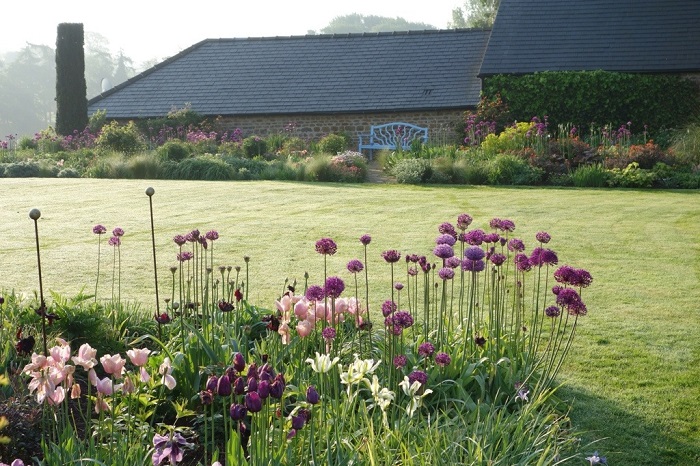
Gardens, like their owners, evolve to reflect changing or mature tastes in plants or styles. Comparatively speaking, what would you have liked to say to your inexperienced self through a time machine?
I would like to say that it was not a waste of time growing all the different plants that I grew in the beginning. I learnt how they all behaved in the ground, which ones were thugs, and which liked the conditions of my garden or not. It took years to develop a taste of my own, and a style of my own, and then to stick to it and not be swayed. I learned to look for interest in the leaf and not just the flower. I like plants that look good for a long time, e.g. six months, but these plants are difficult to find. I buy maybe five, and learnt not to have it look too bitty. I try to have it not look too studied – for example, when we are digging out the bluebells of the beds, we leave some in the right hand side which is more woodland-like.
Rather than take the customary approach of dividing the garden into rooms to prevent the countryside view from dominating, you took the opposite, not easy tactic of allowing the garden embrace the view. How did you keep the garden balanced with the wider panorama?
I always knew that I did not want rooms in my garden, though some people tried to pressure me to divide it up, as that was the fashion at the time. We have gone on and on opening it up particularly by taking out the big rose bushes of Rosa californica ‘Plena’ which were at the end of the lawn stopping the eye. Now we have two yew domes, which is simpler and picks up the picture of the yew in the parterre down below. To keep the garden balanced, not only have the chimneys in the parterre grown a lot and matured (beautifully clipped by Polly), but also we have enlarged the Autumn border and swept it on round to the right to incorporate the landscape. We have taken out the Photinia x fraseri ‘Red Robin’ on the right hand side, and the hedge of Rosa glauca, and planted two separate yew hedges which are going to be tapering with the lie of the land, for it all runs gently downhill.
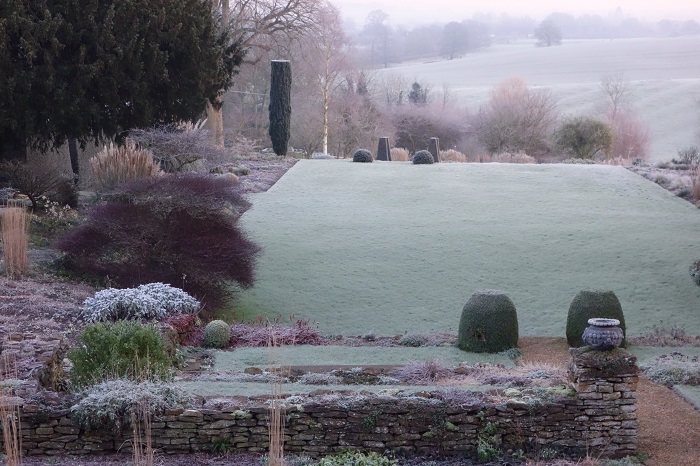
Most modernist gardens depend heavily on hardscaping and herbaceous perennials with grasses, whereas your garden is more accommodating of woody plants. What value do you see in having a diversity of woody plants?
I don't like a lot of hardscaping in a garden. The advantage of woody plants is that the whole thing is going to look more natural. We are a north facing garden, so the plants are going to enjoy dappled shade, and near the house we have stepping stones taking you through the beds. It is only in the last five years that I have discovered the beauty of ferns. However, it is very difficult finding plants that will do well under the shadow of my two large yew trees on the right hand side.
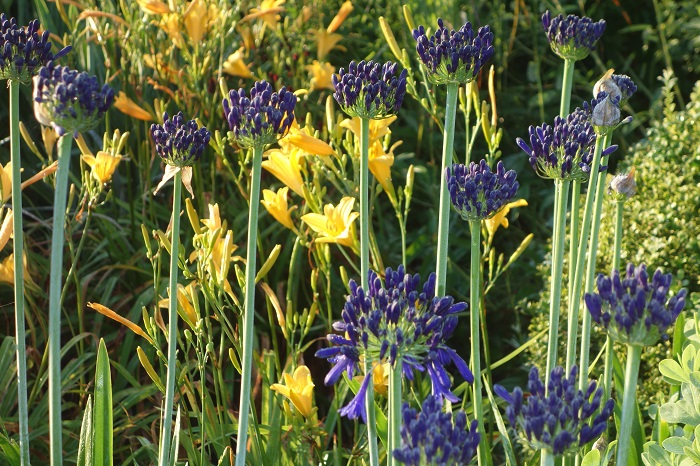
British gardeners are spoilt for plant choices, which can be overwhelming for novices. How do you filter what will work successfully with your garden?
I go to two top class nurseries, which sell plants of my taste. Two of my favorite nurseries are Marchants Hardy Plants owned by Graham Gough and Lucy Goffin, and Avondale Nursery near Coventry. Graham and Lucy and I always have lunch together, when we never draw breath about plants! Polly once went to Marchants, and Graham asked her if she needed any help, to which she said no, as she had seen them all in our garden (she did say quite that to Graham)!
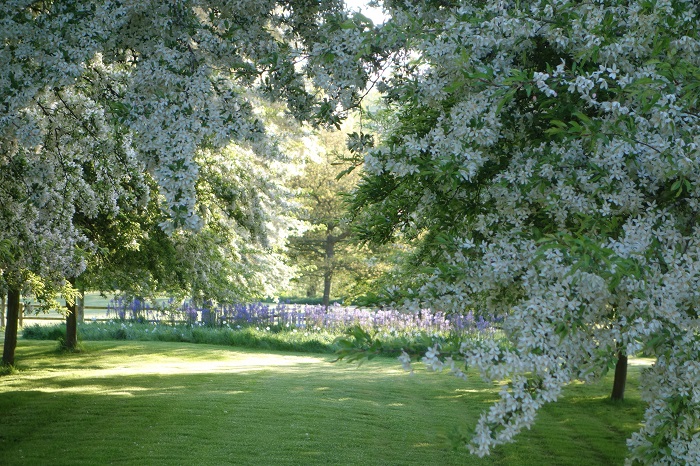
Why is the transcendent or emotional feeling elusive even in the gardens of UK?
Maybe the owner is not emotional, or too many gardens done by designers.
It takes a courageous spirit to apply for a tree preservation order to be rescinded and then remove the tree once the application is approved. Does the sentimentality towards trees prevent gardens from being better?
I don't understand the sentimentality towards trees if it is going to spoil the overall picture, or stop things from growing by sucking up the moisture from the ground. To me it is totally obvious if a tree needs to come out.
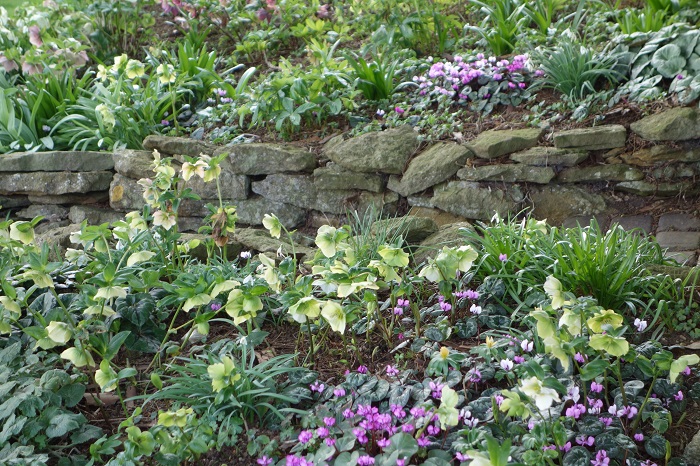
Winters in the British Isles can be gray, damp, and miserable. What in the garden lifts your spirits during those leaden days?
The winter aconites, snowdrops, Sarcococca, Cornus mas, and hellebores, which flower for about 3 months. Particularly the snowdrops and the hellebores.
How often do you and your gardener Polly discuss the garden's evolution?
Constantly.
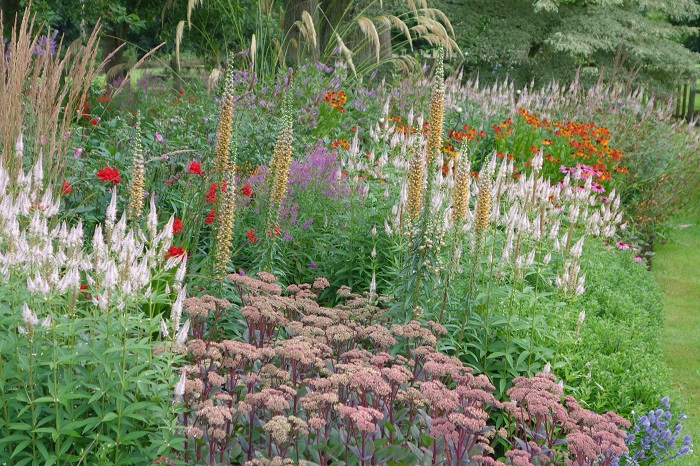
You often allude to artists or their works when describing specific areas of the garden such as the Gustav Klimt border or the Bottecelli meadow. Does this artistic allusion help evoke the atmosphere you and Polly hope to achieve?
Yes it does , and it is not dissimilar to our description.
The inclination to garden or create a garden seems more persuasive in UK than it has been in Corfu, Greece where challenges like hard soil and dry summers appear insurmountable.
Here in the British Isles we have the perfect gardening climate, which is maybe why we talk about the weather all the time! We have had a mild winter, a wet spring, some heat, and now cold again. The plants are growing as you look at them. Corfu is very difficult. It has cold wet winters, with a rainfall the same as London. Spring is beautiful with the soft green of the olive trees, and many wild flowers everywhere. But then follows 3 to 4 months of very hot weather, with poor watering facilities, and poor quality water that is salty. Again in the autumn everything freshens up and looks beautiful again. Before we bought the property, the garden was just an olive grove, without even a single cypress.
What are some of the plants you could not be without in the garden?
I would not be without the yew structure in the garden, and the Phillyreas, particularly Phillyrea latifolia that I grow. I love the Cornus alternifolia ‘Argentea’, and Cornus controversa. The layout of the parterre has turned out much better than I ever thought it would. My new favourite is my golden Cornus mas.
Again and again you have emphasized the effect of clipping your shrubs well so their forms become architectural after the borders have been tidied. What does it take to clip skillfully and beautifully without overdoing it?
Polly does all the clipping, and she does it all beautifully and by eye. In the parterre the shapes tend to be on the large side, such as Daphne tangutica. It is huge but we are frightened of cutting into too hard as we do not want to lose it. Our bushes of Sarcococca are pretty massive, but it all leads to more drama in the winter.
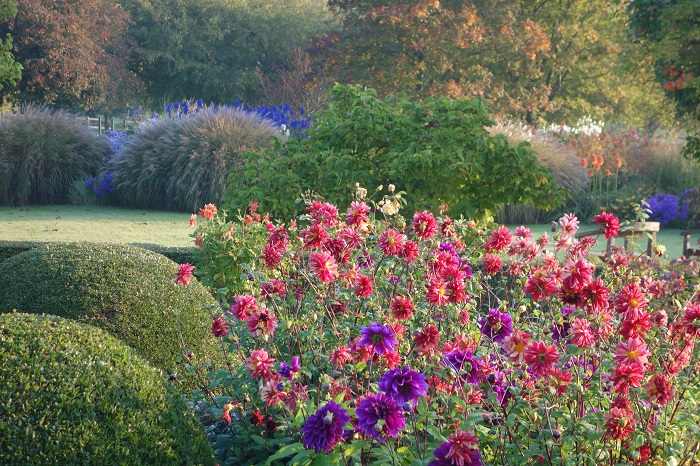
Some people dismiss dahlias and tulips as too much effort - especially lifting and staking for the first, and topping up for the latter. What is it about these two that you and Polly find invaluable for the garden?
Dahlias and tulips are certainly not too much effort. The garden looks beautiful at this moment and it is the tulips making rivers of colour in the borders. Then later on the dahlias in the parterre flower until the end of October, and they are also done to a colour scheme, flowering endlessly, being deadheaded, with flowers for the house.
People gardening in tropical and even Mediterranean climates use scented plants to greater effect than those in temperate climates. What is it about scent you find enthralling in a garden?
Scent in a garden is one of its many joys. James [my husband] has no sense of smell at all which is a shame.
You often get a strong smell particularly in the evening. My favourites are Monarda, and Dictamnus when you brush your hands up its stems.






